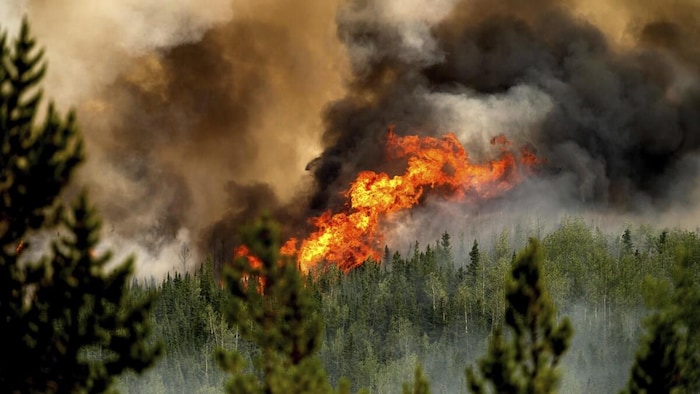Open in full screen mode In Canada, rural and remote communities face higher health and safety risks due to climate change. (Archive photo) Radio-Canada Voice synthesis, based on artificial intelligence, allows you to generate spoken text from written text. Compared to urban dwellers, Canadians living in rural areas are more vulnerable to climate change and face additional barriers to adapting, says a new federal government report. The synthesis report entitled Canada in a Changing Climate, released last week, concludes that climate change is harming the health of Canadians, threatening the country's aging infrastructure and weakening agricultural production and natural resources. It also says Canada is not doing enough to adapt. The document presents 10 conclusions drawn from several reports produced since 2017, which focus on the impacts of climate change in Canada and the country's progress on adaptation. Although some effects like heat islands and urban flooding have received a lot of media attention, the report indicates that rural and remote communities face higher health and of security. In addition, their critical infrastructures would be further threatened. He points out that many rural, remote and indigenous communities rely heavily on agriculture and certain natural resources, notably forests. These communities are particularly sensitive to climate change since they depend on weather conditions and are vulnerable to extreme conditions.
Flooded strawberry plants. (File photo)
Ashlee Cunsolo, a Memorial University researcher who co-wrote the report, believes rural communities could use a lot of advice to give to other Canadian regions in terms of adaptation.
Rural and remote areas have been on the front lines for a long time. They have an understanding of climate that is very different from that of people in other parts of the country, she says.
Ms. Cunsolo works with Inuit communities in the north of the country for more than a decade and studies how climate change affects physical and mental health.
Loading
Hostages killed “by mistake” by the Israeli army brandished a white flag
ELSE ON NEWS: Hostages killed “by mistake” by the Israeli army brandished a white flag
She finds that people in rural areas are disadvantaged in many ways compared to urban dwellers, including employment opportunities and access to health care.
When we look at the disparity in inequities and in the current and projected impacts of climate change, there are fundamental particularities in these regions that we must take into account, explains the researcher.
Ashlee Cunsolo (Stock photo)
One of these aspects is transportation, since remote communities have limited access to the road network. Some communities rely on seasonal ice roads that form on lakes when temperatures are cold enough. These roads are expected to become rarer with climate change.
If ice roads do not form and transportation cannot be carried out, this causes major supply problems for food and drinks. #x27;other goods, notes Ms. Cunsolo.
Several communities with which the researcher works depend on air transport to obtain food and basic necessities as well as to obtain certain health care.
There are a lot of storms in the North and in remote areas in particular, says Cunsolo. People can't fly to medical appointments and emergency services can't get there.
An Air Inuit plane takes off at the Kuujjuarapik airport. (File photo)
Dr. Kyle Merritt, a family physician who runs the emergency department at Kootenay Lake Hospital in Nelson, British Columbia, describes a similar situation. Over the years, the local community has seen the centralization of health services in Kelowna, a larger city four hours away.
Even our food and laundry services come from Kelowna, Dr. Merritt points out.
He explains that transporting patients to Kelowna is difficult even when everything is operating normally.
As soon as there is a disruption, more nothing works, he said. Having more services in our community would strengthen our resilience.
Wildfires have been a recurring problem for several years in small communities like Nelson, which is surrounded by forests and mountains.
It can there will be very dense smoke for weeks, adds Dr. Merritt.
In Scotch Creek, British Columbia, Forest fires ravaged several homes and properties last summer. (File photo)
The situation is particularly difficult for patients who suffer from asthma or respiratory problems. Sometimes, even at this time of year, some people have not fully recovered from smoke episodes.
Forest fires also have repercussions on the mental health of members of the Nelson community.
Although the city never had to be evacuated due to fires, Dr. Merritt notes that the threat weighs heavily on residents. People fear their homes will burn to the ground, which is an increasingly real risk.
Communities affected by the effects of climate change have already started to find solutions, says Ms. Cunsolo.
There is a lot of resilience and innovation in rural and remote regions, which are located at the forefront of adaptation in Canada.
In particular, walls are built there to prevent the sea from invading the shores and buildings are adapted so that they resist changes in the permafrost. Telemedicine and other remote services are also being improved.
Fiona Warren, the lead author of the study, says, however, that rural communities have fewer resources to adapt to climate change, including labor, road access and health services.
They may be more vulnerable because they do not have the resources necessary to deal with this problem, explains this manager of the evaluation at Natural Resources Canada.
At the same time, they [rural communities] also have strengths; social cohesion is often stronger there. People really look out for their neighbors.
I would like people to be inspired because there are a lot of things being done, says Warren , but at the same time, one of the key conclusions of the report is that we are not doing enough in terms of adaptation.
< em>Based on reporting by Emily Chung and Carly Thomas of CBC News

